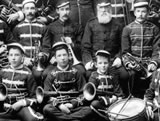What happened that day?
See historic events for any day of the year by entering the date below. Why not try your birthday?
Kiwi of the Week
Today in History

1880 First inter-city brass band contest
An audience of 2500 people was on hand for the first inter-city brass band competition held at the Drill Hall in Christchurch. Six bands competed and the audience chose the winner. The people's choice was the Invercargill Garrison Band, under the command of Captain W.E. Heywood.
Heywood was one of the pioneers of the brass band movement in New Zealand, which had strong military origins. In the early colonial years the bands of the various Imperial regiments provided music for state and civic occasions, vice-regal balls and public concerts. The traditions established by these Imperial bands were continued by their Militia and Volunteer counterparts. The band of the Taranaki Volunteer Rifles, formed in 1859, is believed to have been the first in New Zealand.
As the New Zealand Wars came to an end many military bands were replaced by community bands associated with local volunteer organisations like fire brigades or in some cases factories and trade unions. For many years almost every township had its band, which could be relied upon to parade on the flimsiest pretext. These bands became a symbol of local pride and identity.
Brass bands in New Zealand have been described as ‘the working man's symphony orchestra’. A good example of this is the Woolston Brass Band, which was formed in May 1883 and came to represent the strong working-class identity of that Christchurch suburb. In the 20th century Woolston became the centre of New Zealand's rubber industry. Appropriately, this famous band is now the Skellerup Woolston Brass Band, named after its major sponsor, rubber manufacturing firm Skellerup Industries Ltd.
The military traditions of brass bands in New Zealand are continued today through the extremely popular and versatile Central Band of the Royal New Zealand Air Force, the New Zealand Army Band and the Band of the Royal New Zealand Navy.
Image: Wanganui brass band, c1880s (Timeframes)














